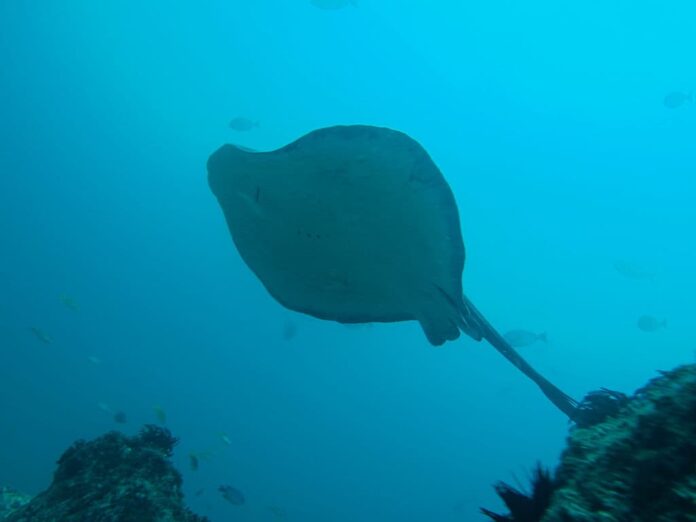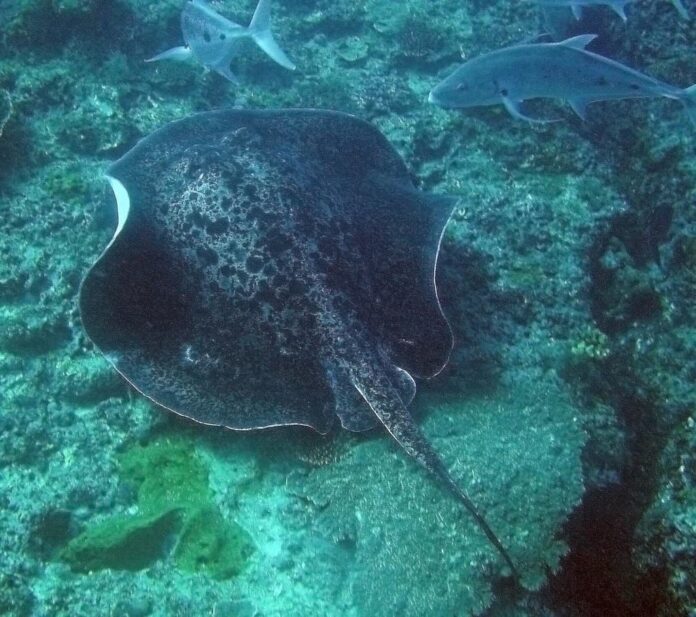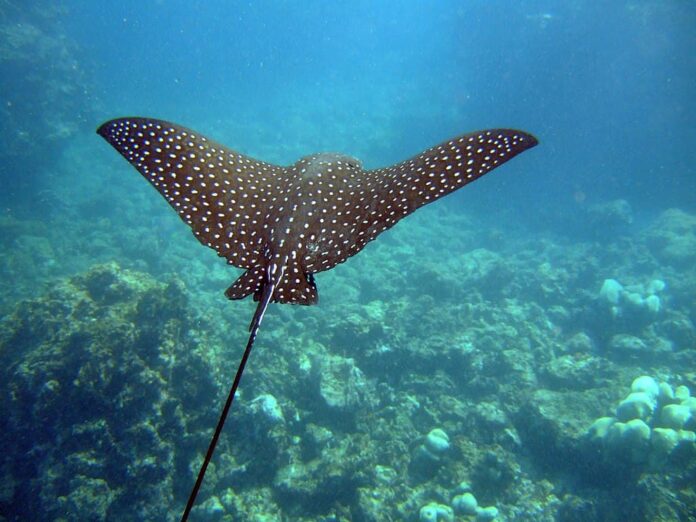Do you know that saltwater rays are actually close relatives of sharks? Some of the biggest rays and stingrays look quite intimidating although some of them are harmless to humans. There are over 600 species of rays, and we will look into only the 10 biggest rays and stingrays today. You probably know the biggest ones, so let’s check out the list below.
10Cownose Ray

Size: 28 – 110 centimeters (0.9 – 3.6 feet)
Got the name from the shape of its head, a cownose ray has a unique feature. It has long and pointed pectoral fins along with a crease in the lobes and a notched head. This creates a cow-nose likeness; hence its name. This ray species lives in brackish coastal waters and shallow marine, and some of them form large schools of up to 10,000 individuals. Another unique thing about cownose rays is that they have poisonous stingers while they are not stingrays. However, the venom on those spines is weak so the symptoms are not different from a bee sting. They are dangerous only when humans step on their spine because they are shy and surface swimmers.
9Sharpsnout Stingray

Size: 70 – 150 centimeters (2.2 – 4.9 feet)
Probably quite small compared to the others in the list, sharpsnout stingrays are very interesting creatures. You can find these stingrays only in shallow brackish water from Venezuela to northern Brazil. Although the size is relatively small, this stingray species also has sharp venomous tail spines that we should be aware of. Those spines are potentially harmful to humans, and they can cause excruciating pain upon contact. However, small-scale fishing households still catch and consume them in some areas. This is why this ray species is now critically endangered due to the decrease in their number.
8Devil Ray

Size: 1.1 – 5.2 meters (3.6 – 16.1 feet)
The devil rays aka Mobulas are one of the largest rays with interesting appearances and behaviors. A devil ray has cephalic horns that point forward rather than curling around the mouth like their relatives Manta Rays. Those horns are the features that bring them their name “Devil Rays”. These rays are fascinating divers as they are one of the fastest marine species in the world.
On top of that, they can even jump and flip out of the water; hence another name “Flying Rays”. At the same time, devil rays can also dive to a depth of nearly 2 kilometers, making them one of the deepest ocean divers. In spite of what they can do, devil rays are very harmless and shy creatures who prefer to feed on krill and plankton.
7Thorn-Tail Stingray

Size: 1.8 – 4 meters (5.9 – 13.2 feet)
This is one of the biggest stingrays that live in the depths of the sea as bottom dwellers. Compared to some of the largest stingrays out there, this one is among the most dangerous to avoid. A thorn-tail stingray or black stingray has a very long whip-like tail with either one or two venomous serrated spines. At the same time, it also has stout sharp thorns along with the middle of its disc and tail. Together, those are their potential weapon to protect themselves from predators out there. It is true that these rays are approachable and docile, but their spines can cause injuries to humans. Some divers even “ride” them in the sea, just make sure to be careful and everything will be fine.
6Butterfly Ray

Size: 2.1 – 3.9 meters (7 – 13 feet)
Just like the name suggests, this species of ray looks similar to a butterfly. It is one of the biggest rays broad and flat diamond-shaped body with a short tail. Unlike some rays that like swimming on the surface, this one prefers the muddy and sandy bottoms of brackish and coastal areas. With the dark brown colors with some dark blotches, these rays camouflage perfectly into their habitats for hunting. As ambush predators, the butterfly rays blend themselves in the sand before grabbing crustaceans, mollusks, and small fish. Butterfly rays are neither aggressive nor dangerous to humans, but they will utilize their painful yet non-lethal spines if stepped on.
5Bull Ray

Size: 2 – 4.3 meters (6 – 14 feet)
Also goes by the name of Smooth Stingray or Short-Tail Stingray, this was the species that killed Steve Irwin. The fascinating thing about bull rays is that they often have 2 strings. A smaller one in the front and another one in the rear that usually bears toxin glands. These stingrays are shy and quick to retreat when humans approach. However, they are not afraid to use their long venomous spines when they feel threatened; hence the tragic accident. This species also faces threats to its population due to fisheries and habitat degradation, and they are not critically endangered.
4Giant Freshwater Stingray

Size: 2 – 5 meters (6 – 16.4 feet)
The giant freshwater stingray is one of the heaviest and biggest freshwater fish in the world. This species only occurs in some estuaries and river systems of Southeast Asia, Borneo, and northern Australia. As bottom-dwelling creatures, these stingrays inhabit muddy and sandy areas where they feed on invertebrates and small fish. The fascinating thing about them is their thin cylindrical tails with a length almost equal to the length of their whole body. At the same time, their spine is the largest of any stingray species out there at 38 centimeters (15 inches) in length. The stingray is not aggressive, but their spines contain toxic mucus along with the strength to pierce bone. Their main threats nowadays are damming, habit degradation, land development, and overfishing.
3Spotted Eagle Ray

Size: 3.3 – 5 meters (10.8 – 16.4 feet)
Spotted eagle rays, from the eagle rays family, are one of the biggest saltwater rays that you can easily recognize right away. Their surface is covered by white rings or spots, and they receive their name from their peculiar snout shape. Their snouts are round and pointed at the tip which resembles a bird’s beak. These large rays often swim along the bottom of the sea or near the surface. The cool thing about them is that they are capable of leaping completely clear of the water when pursued. That is not all, this species also has a long tail with up to 6 venomous spines at the base for self-defense. Due to the population decline resulting from overfishing, these rays are now considered to be near threatened.
2Reef Manta Ray

Size: 3.5 – 5 meters (11 – 16 feet)
Here you are looking at the second biggest rays in the world that live in subtropical and tropical waters of the oceans. Since they prefer to swim in shallow waters along the coastal reefs, it is common for them to encounter divers and snorkelers. Their bodies have a unique transition between black and white markings on the dorsal surface that forms a V. These docile large rays feed on by filtering the seawater to catch zooplankton. Reef manta rays are now classified as vulnerable due to climate change, entanglement, illegal fishing, and plastic pollution.
1Giant Oceanic Manta Ray

Size: 4.5 – 7 meters (15 – 23 feet)
The giant oceanic manta rays or manta rays are the biggest saltwater rays in the world. These largest rays are found in subtropical and tropical waters as well as temperate waters. Some giant manta rays are seabed dwellers while others prefer to swim on the surface instead. Another fascinating thing is that these rays either travel alone or in a large group of up to 50 members. Despite the large size, giant manta rays still have a few predators including large sharks and dolphins (orcas). As for their current population, these large rays are now considered to be endangered due to overfishing.
Related Post: Largest Turtles




